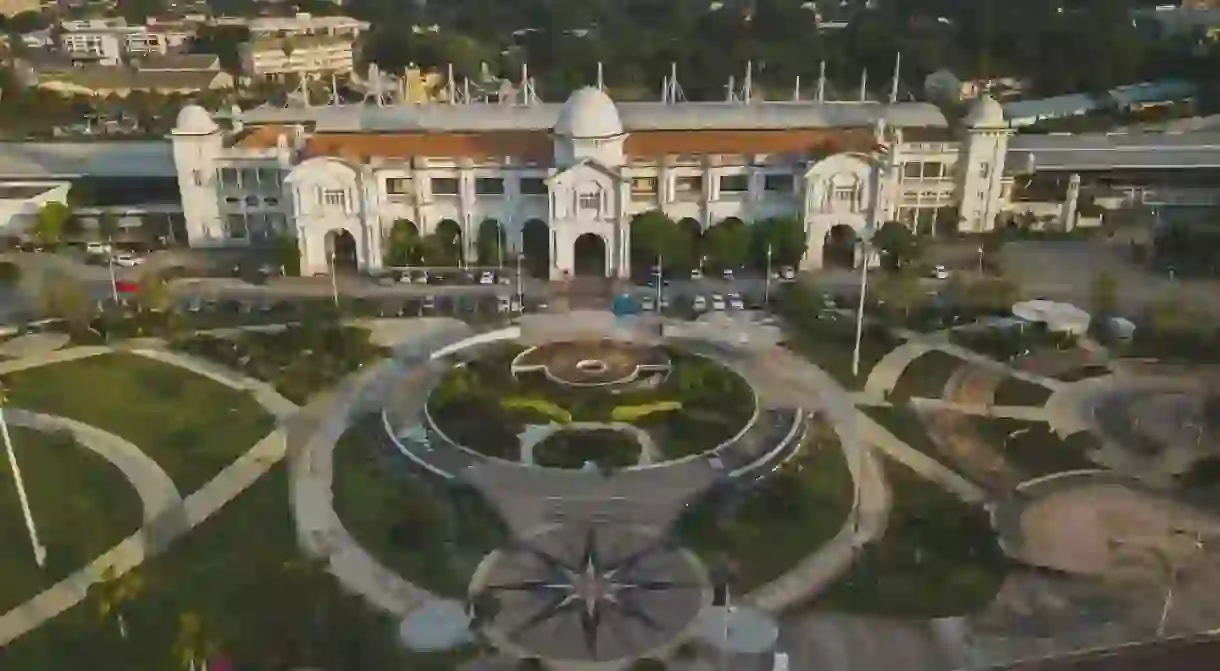The Most Beautiful Architecture in Ipoh, Malaysia

The 19th-century tin mining boom influenced much of the present-day architecture in Ipoh. From classic British colonials and former bungalows to exclusive Hakka Clubs and the Ipoh State Mosque, here are Culture Trip’s favourite buildings in Ipoh.
Ipoh Railway Station
Train Station

One of the more captivating examples of architecture in Ipoh is often among the first visitors see: Ipoh Railway Station. Renowned British architect Arthur Hubbard, the same person behind Kuala Lumpur’s magnificent station, designed this state landmark in the early 20th century. Featuring a mixture of Neo-Moorish and Indo-Saracenic elements with hints of British Indian styles, the grand Railway Station sits grandly in the heart of Ipoh’s colonial centre.
Majestic Station Hotel
Building
Often referred to as the ‘Taj Mahal of Ipoh’, the Majestic Station Hotel shares the same buildings as the Railway Station. With a Victorian and Moorish-inspired façade, the former hotel retains a slight air of colonial grandeur. Once catering for wealthy Brits and later tourists, the once glorious structure sits abandoned today.
Ipoh High Court
Building

Designed by Arthur Hubbard and completed in 1928, Ipoh High Court exhibits some of the most beautiful architecture in Ipoh. The white-washed neo-classical building stands elegantly opposite Ipoh Railway Station in the heart of the old town. While tourists can’t go inside, it does provide an attractive setting to capture the essence of colonial Ipoh.
Han Chin Pet Soo
Museum

In the 19th century, this elegant building in Ipoh housed the Hakka Miner’s Club. Chinese Hakkas used the space for all kinds of shadowy activities including gambling, prostitution and as a haven for local triad organised crime groups. Today the three-storied creamy-yellow building with ageing wooden shutters over the windows has become the Han Chin Pet Soo Museum. Inside artefacts and relics from the former tin mining days offer an insight into Perak’s history.
Ipoh Town Hall and Old Post Office
Building

The Town Hall and Old Post Office feature among the highlights on the Ipoh Heritage Walk. With Neo-Renaissance, Moorish and Victorian-inspired styles, the white structure exudes colonial splendour. Town Hall once sat at the front while the Post Office occupied the back when it opened in 1917. The best way to photograph this elegant architecture in Ipoh is from the Railway Station Square.
Darul Ridzuan Museum
Museum

The custard-yellow colonial building along Jalan Panglima approximately 10 minutes on foot north of the Railway Station houses the Darul Ridzuan Museum. While the contents of the museum are somewhat underwhelming, the 1926 former bungalow is worth the walk to admire its style. The residence once belonged to a wealthy Chinese tin miner before becoming a state administrative centre in 1950. The museum opened in 1992. Neat lawns and a water feature mark the front of the Darul Ridzuan Museum.
Birch Memorial Clock Tower
Building, Memorial

From a distance and at the right angle, the Birch Memorial Clock Tower resembles a rocket about to lift off into space. Stand closer and the historical landmark from 1909 combines a variety of architectural styles and elements. The square tower consists of four side panels said to represent the growth of civilisation. Images, sculptures and busts decorate the apex near the oversized bell. The clock tower acts as a memorial to the first British resident of Perak, James Birch, who was murdered by Malay chiefs in 1875.
Royal Ipoh Club
Building
Holding the title as the oldest club in Ipoh dating back to 1885, the Royal Ipoh Club has catered for Perak’s wealthy for more than a century. Housed inside a colonial bungalow overlooking Padang Ipoh, the elite club offers fine dining, sports facilities and regular social events. The small, elegant colonial near Ipoh High Court is a favourite on the Ipoh Heritage Walk.
Ipoh State Mosque
Mosque

Step outside the Railway Station and see the dominating Ipoh State Mosque. Officially the Sultan Idris Shah II Mosque named after the Sultan who commissioned it in the 1960s, the two-storied structure has some of the best Islamic architecture in Ipoh. Symmetrical ‘U’-shaped patterns interspersed with crisscrossing air vents cover the mosque’s white façade. The 38-metre (125-foot) minaret and 44 orange domes decorate the exterior.
St. John's Anglican Church
Church
Located near Ipoh Royal Club, St John’s Anglican Church was once one of Malaysia’s largest churches. Dating back to 1912, the heritage building once served the colonial Anglican community. Oddly, it became a noodle factory during the Japanese occupation in World War Two. The bare-brick design offers a refreshing break from the seemingly ubiquitous stucco dominating most architecture in Ipoh.













